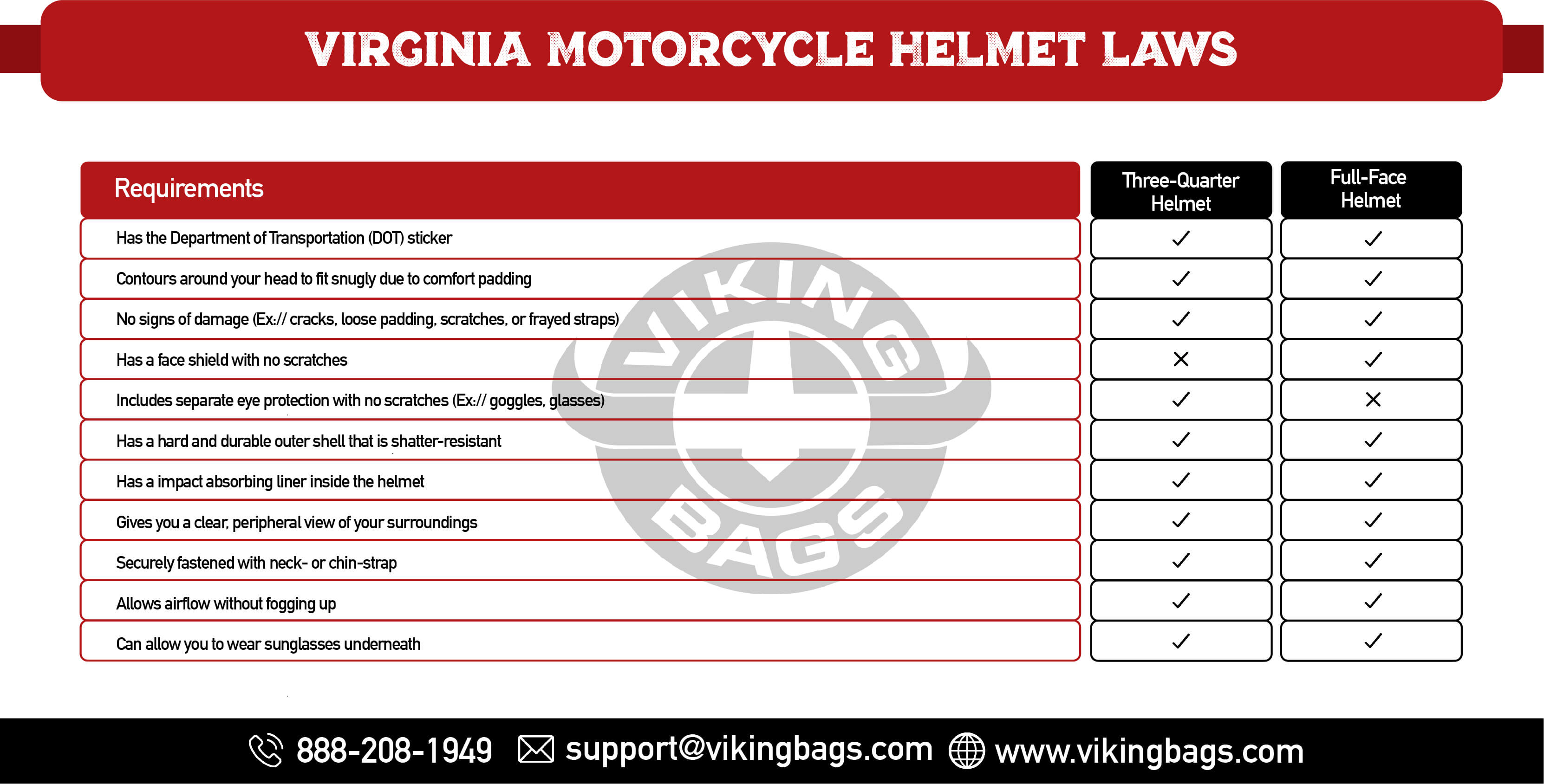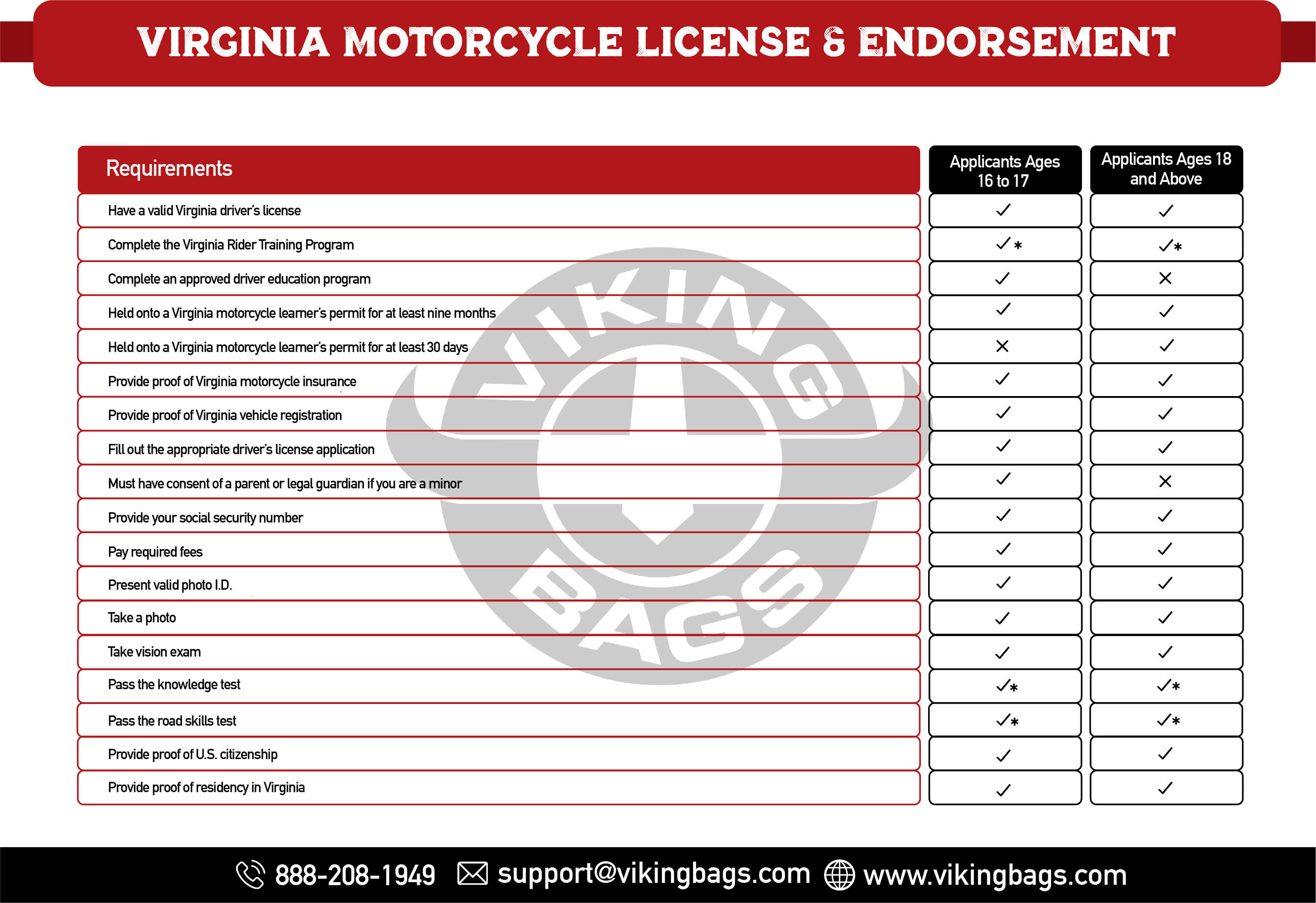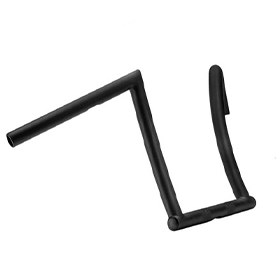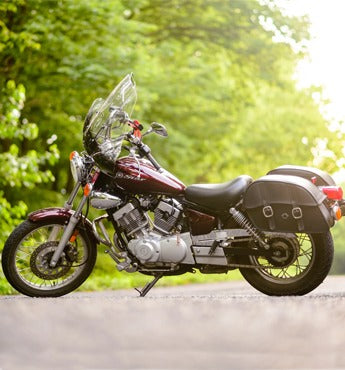- Table of Contents
- 1. Introduction
- 2. Virginia Motorcycle Insurance
- 3. Virginia Motorcycle Helmet Laws
- 4. Virginia Motorcycle License Laws
- 4.1 Virginia Motorcycle Learner’s Permit
- 4.2 Virginia Motorcycle License & Endorsement
- 4.3 Virginia Motorcycle License Test
- 5. Virginia Motorcycle Passenger Laws
- 6. Virginia Lane Splitting Laws
- 7. Virginia Motorcycle Equipment Requirements
- 8. Sources
1. Introduction
While being physically adept, aware of one’s surroundings, and knowing how to operate a motorcycle contribute to your ability to ride safely, these factors are a small part of what it means to be a responsible motorcyclist. Like with any motor vehicle, there are general traffic laws and rules of the road that motorcyclists must comply with. However, because motorcycles are considered their own class of vehicle, there are additional regulations that must be followed. And depending on where you live in the United States, motorcyclists can either have greater freedom or further restrictions to consider. Whether you are a novice or a veteran rider, it is always good to review the latest version of the motorcycle laws within the state you currently reside in.
This infographic will provide an overview of the essential motorcycle laws and a step-by-step explanation of the licensing process in the state of Virginia.
2. Virginia Motorcycle Insurance

If you wish to be eligible to purchase a license plate, you must first prove that your vehicle is protected by minimum insurance requirements or that you have paid the Uninsured Motor Vehicle Fee.
The Uninsured Motor Vehicle Fee requires that you pay $500 to be allowed to operate your motorcycle uninsured at your own risk. Keep in mind that this is not a replacement for Virginia motorcycle insurance.
If you are found at fault for an accident, your insurance will help you to provide compensation to any affected parties. Whenever you take your motorcycle out for a ride, have proof of ownership stored on your vehicle. You must be able to provide proof of Virginia liability insurance coverage at traffic stops, accident scenes, and vehicle inspections.
Your Virginia liability insurance coverage must be able to cover the minimum costs for the following accident-related fees:
- $25,000 for bodily injury to a person per accident
- $50,000 for bodily injuries to multiple people per accident
- $20,000 for property damages sustained per accident
If you wish to protect your health and property, you will need to acquire optional forms of motorcycle insurance coverage. As these are not mandatory, only purchase what you can afford and what will be useful under specific circumstance during an accident:
- Uninsured coverage
- Underinsured coverage
- Collision coverage
- Comprehensive coverage
3. Virginia Motorcycle Helmet Laws


As Virginia has a universal motorcycle helmet policy, all motorcyclists regardless of age are required to wear protective headgear when they are operating their vehicles in this state.
While the use of a motorcycle helmet is enforced in Virginia, here are statistics from recent studies to help explain the importance and benefits of having them on at all times:
- Motorcycle helmets are 29% effective in preventing motorcycle fatalities
- Motorcycle helmets are 67% effective in preventing brain injuries
- Riders without protective headgear are 40% more likely to suffer fatal head injuries
An approved motorcycle helmet accepted in Virginia must have been made with quality materials by the Snell Memorial Foundation or the American National Standards Institute. It must also comply with the safety parameters set by the U.S. Department of Transportation.
The two models that meet the criteria stated above while providing protection and visibility are three-quarter and full-face helmets.
Listed in this table below are the features that your motorcycle helmet is required to have if you wish to operate a motorcycle in Virginia:

4. Virginia Motorcycle License Laws
4.1 Virginia Motorcycle Learner’s Permit
You can begin applying for a Virginia motorcycle learner’s permit if you are at least 16 years and 3 months of age or above.
You will have to pay a fee of $3 to be issued a Virginia motorcycle learner’s permit that is valid for at least 8 years.
To be given the permit, you must complete the following tasks and fulfill all of the listed criteria:
- If you are under the age of 18:
○You must hold onto the motorcycle learner’s permit for at least nine months
- If you are 18 years old or above:
○You must hold onto the motorcycle learner’s permit for at least 30 days
- Present identification documents
- Provide proof of Virginia residency
- Provide proof of U.S. citizenship
- Provide your Social Security Number
- Take a photo
- Pass the knowledge exam
- Pass the vision exam
- Pay the required fees
When you are operating with a Virginia motorcycle learner’s permit, you will have to comply with the following restrictions as you practice:
- You cannot carry passengers
- You must wear an approved motorcycle helmet plus eye and face protection
- You must be supervised by a 21-year-old or older with a valid motorcycle license and is capable of assisting you from a separate motor vehicle
4.2 Virginia Motorcycle License & Endorsement
You are eligible to receive a Virginia motorcycle license if you are at least 16 years and 3 months of age or above.
You will have to pay a fee of $2 per valid year to be issued a Virginia motorcycle endorsement for your driver’s license. If you decide to get the motorcycle-only driver’s license, you will have to pay a fee of $6 per valid year and is typically valid for up to 8 years.
Listed below are the requirements you will need to fulfill to obtain a Virginia motorcycle license. Depending on your age when you approach the final step, the list of criteria may differ between motorcyclists:

*If you provide a Virginia Rider Training Program certificate of completion within one year of completing the course, you will have the obtain of waiving both the knowledge and road skills portions of the Virginia motorcycle license test.
*If you are 19 years old or above, the Virginia Rider Training Program certificate of completion will serve as your temporary “M2” or “M3” endorsement for your driver’s license for 30 days after completing the course.
4.3 Virginia Motorcycle License Test

Knowledge Portion:
- Will be completed on touch-screen computers
- Complete 25 multiple-choice questions
- Questions will be based on content from Virginia Motorcycle Operator Manual
- Will be tested on understanding of road rules and safe riding practices
- Requires a passing grade of 80% or higher
Riding Skills Portion:
- Will be conducted in a controlled, off-street area
- Your motorcycle will be subjected to a pre-ride inspection to ensure it meets safety standards
- Demonstrate basic understanding of motorcycle operation
- You will be tested on your ability to stay within the speed limit, adjusting speed and position, maintaining visibility, operating under stress, accelerating, braking, turning, stopping, and swerving
- The examiner will grade you based on how well you ride at safe speeds, stay within the lanes, and demonstrate riding maneuvers
The examiner will stop the road skills portion of the Virginia motorcycle license test if you demonstrate the following behavior:
- If you operate your motorcycle in an unsafe manner
- If you fail to follow the instructions of the examiner
- If you accumulate too many points
If you fail the road skills portion of the Virginia motorcycle license test twice, you must complete a Virginia Rider Training Program before adding a Class M endorsement to your driver’s license.
5. Virginia Motorcycle Passenger Laws

In Virginia, there is no minimum age requirement for motorcycle passengers. Any motorcycle passenger regardless of age is required to wear an approved motorcycle helmet at all times. Their motorcycle helmet must meet the criteria listed in the earlier section.
For it to be legal to carry a passenger, your motorcycle must be outfitted with equipment specifically designed to provide secure yet comfortable seating for one additional person. The required equipment will include a designated passenger seat and footpegs.
The designated passenger seat can only be fixed to the sides or at the rear of your motorcycle. There must be space between the driver and passenger seats to allow the passenger to fully extend his/her legs on both sides. This will also prevent the passenger from interfering with the operator while handling the motorcycle. The designated passenger seat can only be positioned at the following places on your motorcycle:
- The back part of a large driver’s seat
- Towards the rear as a separate saddle
- Fixed to the side as a sidecar
Because there is no age restriction, you will have to consider other criteria when deciding who can safely ride with you. A popular rule of thumb is that a passenger must be able to reach and plant their feet against the footpegs. Therefore, it is best to avoid transporting young children or elderly individuals. Other characteristics to look for in a motorcycle passenger include the following:
- Your passenger must be able to reach the footrests
- Your passenger must wear an approved motorcycle helmet
- Your passenger cannot be carrying any packages
- Your passenger must be able to understand and follow your directions
6. Virginia Lane Splitting Laws

Motorcyclists are prohibited from practicing any form of lane splitting while traveling through Virginia. Because lane splitting involves getting precariously close to larger vehicles and maneuvering in their blind spots, the chances of getting into a fatal accident become higher. To avoid collisions and trouble with local law enforcement, motorcyclists should avoid engaging in the following behavior:
- Riding on top of the dividing lines between lanes
- Riding in between adjacent rows of stopped vehicles
- Overtaking a larger vehicle ahead in the same lane
Thanks to the high maneuverability and compact design of motorcycles, riders are entitled to certain rights regarding how they can act when on the road. Motorcyclists are allowed to attempt the following behavior in Virginia:
- You are allowed to make full use of the space within your current lane
-
You can only share a lane with another motorcycle if:
○Both parties stay apart at least two abreast
○Both parties consent beforehand
7. Virginia Motorcycle Equipment Requirements
One of your duties as a motorcyclist is to conduct a motorcycle vehicle inspection every year to ensure that it meets Virginia’s safety and equipment standards. Unlike other motor vehicles, a motorcycle needs to be checked and given maintenance frequently. Due to the lack of redundant systems, any primary components that start to break down on your motorcycle could result in total mechanical failure. If you discover any signs of damage, do not put it off until the last minute. Apply the repairs yourself using your tools or take it to be seen by a mechanic.
Listed below are the equipment your motorcycle must be fitted with to be considered street legal in Virginia. These components are essential to your motorcycle’s maneuverability, visibility, and overall functionality:
- Horn
- Wheels
- Tires
- Handlebars
- Front & Rear Brake
- Controls
- Headlight
- Taillight
- Brake Light
- Turn Signals
- Exhaust system
- Muffler
- Rearview mirrors
8. Source
 www.vikingbags.com
www.vikingbags.com
888-208-1949
391 Thor Pl,
Brea, CA 92821















Leave a comment
All comments are moderated before being published.
This site is protected by reCAPTCHA and the Google Privacy Policy and Terms of Service apply.